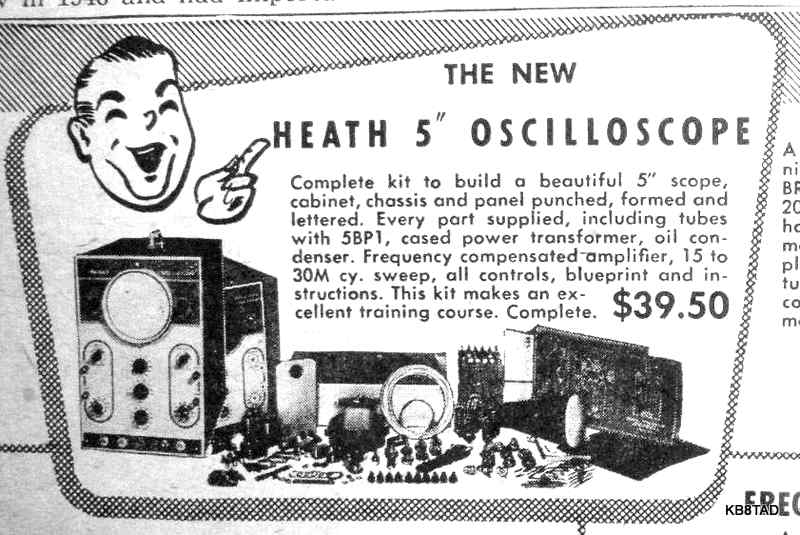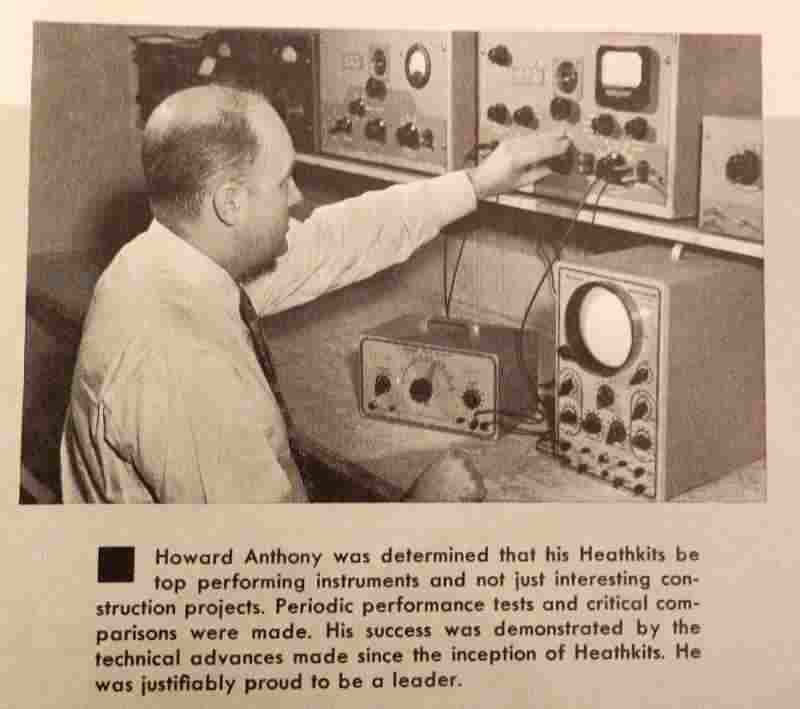Hi-Fi Hall of Fame
Business Inductee
Heathkit

Introduction
Our next nominee for induction is Heathkit, a business that specializes in the production and sale of electronic kits for hobbyists and enthusiasts. The company, originally founded as Heath Company by Edward Bayard Heath in the early 20th century, initially gained recognition for its involvement in aviation and the manufacturing of aircraft.
In the post-World War II era, Heathkit transitioned its focus from aviation to electronics. The company became well-known for producing a wide range of electronic kits, allowing individuals to assemble their own electronic devices, ranging from radios and amplifiers to test equipment and even early computers. Heathkit’s kits typically included all the necessary components, along with detailed instructions and schematics for assembly.
One of Heathkit’s notable areas of expertise was in the production of high-fidelity audio equipment. Enthusiasts could purchase Heathkit kits to build their own amplifiers, tuners, and other audio components. The DIY (do-it-yourself) aspect of Heathkit products appealed to hobbyists who enjoyed assembling and customizing their electronic devices.
Heathkit’s popularity peaked in the mid-20th century, and many of its products became iconic in the world of amateur electronics. The company went through various ownership changes and faced economic challenges over the years. While Heathkit experienced a decline in the late 20th century, the brand left a lasting legacy among electronics hobbyists and DIY enthusiasts. In recent years, there have been efforts to revive the Heathkit brand.
Key Facts
| Company | Heathkit |
| Business | Electronic Kits |
| Founded | 1909 |
| Website: | shop.heathkit.com |
Founding of the Heath Company
The original Heath company was established by Edward Bayard Heath, an accomplished American airplane racer who constructed and piloted the Heath Parasol, a compact, single-seat aircraft. The original prototype used surplus wings from a Thomas-Morse S-4, a World War One fighter trainer.

In keeping with his passion for making aviation more accessible, Heath sold blueprints for individuals to construct their own Parasol. He marketed Parasol kits, if people wanted to build their own, as well as fully assembled versions. Blueprints were priced at $99, kits were sold for a few hundred dollars, or the fully assembled plane could be bought for less than $1000.

Tragically, Edward Heath met his demise in a plane crash in 1931.
Walter Clinnin assumed control of the company on May 1, 1931, and, enticed by a rent-free facility, relocated the entire operation to Niles, Michigan. Approximately 12 employees joined the move. In 1934, the company underwent reorganization as the International Aircraft Corporation. Unfortunately, due to poor management and other issues, the Heath company faced financial distress and declared bankruptcy in 1934.
Howard Anthony Purchase of Heath Company
In 1935, Howard Anthony acquired the Heath Company, and directed his attention towards making accessories for small aircraft. Following World War II, Anthony made a strategic decision to shift the company’s focus from aircraft equipment to electronics. He procured a substantial inventory of surplus wartime electronic components with the intent of creating electronic kits that could be assembled by hobbyists in their own home.

In 1947, Heath unveiled its inaugural electronic kit, the Heath O1 oscilloscope featuring a 5-inch diameter cathode ray tube display (CRT), priced at an unbeatable US$39.50. This competitive pricing contributed to the oscilloscope’s significant success, establishing it as a best-selling product during that period.

Buoyed by that initial success, Anthony broadened the Heath product range, initially concentrating on test equipment and amateur radios. The first audio products emerged in 1947, comprising simple low power amplifiers crafted from surplus wartime components.

Heath first began selling “Heathkit” branded products in 1947. By the 1950s, home high fidelity systems were getting popular, and so the company began producing Heathkit amplifiers, tuners, and speakers to address this growing market.

Tragic Passing of Howard Anthony
Sadly, Howard Anthony was killed in a plane crash in 1954, just as the Heath company was starting to experience considerable success. The company was sold to Daystrom, and later to Schlumberger, which was a pioneering force in electronic techniques for oil exploration. Despite the loss of its founder, the Heath company flourished and maintained a noteworthy portfolio of Hi-Fi products for many years.

The Golden Age of Electronic Kits
Besides Heathkit, there were a number of companies producing electronic kits for the Hi-Fi market. Allied Radio, a supplier of electronic components, had its KnightKits. Lafayette Radio Electronics sold a selection of kits. Radio Shack ventured into this market with its Archerkit line, and Dynaco made audio products available in kit form known as Dynakits. Other competitors included H. H. Scott, Inc., Fisher, and Eico.

This period was the “golden age” of electronic kits, marked by a wide range of excellent kits from a number of excellent manufacturers. These decades also saw remarkable improvements in Hi-Fi technology and performance.



Personal Computers and Acquisition by Zenith
By the 1970s, Heathkit set its sights on a new frontier: the burgeoning world of home computers. This foray proved to be both triumphant and turbulent, reflecting the dynamic nature of technological advancement.
Heathkit’s entry point was the H89, a clone of the popular Altair 8800. By offering a more affordable option to hobbyists, they tapped into the zeitgeist of DIY computing and nurtured a passionate community around their modular, well-documented machines. Each kit provided not just a computer, but an educational journey into the inner workings of hardware and programming.

In 1979, recognizing the potential in Heathkit’s burgeoning computer kit business, the Zenith Radio Company swooped in and purchased the Heath company, purchasing the company for $64.5 million. For Heathkit, the acquisition offered a lifeline. They gained much-needed resources and capital to compete in the rapidly growing and complex computer industry. Zenith’s brand recognition and marketing prowess could potentially propel them beyond their niche market of dedicated hobbyists. However, there were concerns that Heathkit’s unique DIY philosophy and emphasis on learning might be compromised under the Zenith corporate umbrella.
The End of the Kit Era
The joint venture was successful, but the rising popularity of home computers as a hobby had an unexpected adverse effect on the company. Many customers shifted from assembling Heathkits to writing computer programs, impacting Heath’s business. Furthermore, while kit assembly remained an intriguing and educational hobby, it was no longer cost effective compared to selling preassembled computers.
The ongoing trend toward integration (printed circuit boards, integrated circuits, etc.) and the mass production of electronics undermined the fundamental Heathkit business model. Assembling a kit remained enjoyable, but the cost savings diminished. The shift to surface mount and integrated circuit components made it increasingly impractical for home assemblers to construct electronic devices at a significantly lower cost than factory-made products.
Sadly, all of these factors meant that the era of the electronic kit was drawing to an end. In March 1992, Heath announced the discontinuation of electronic kits after 45 years. The company struggled to survive; Heathkit carried on selling educational products for twenty years, but eventually filed for bankruptcy in 2012.
A Heathkit Revival?
Just a year after declaring bankruptcy, in May 2013, new owners announced a plan to revive the company and to resume electronic kit production and sales. Since then, Heathkit has announced and sold a few kits in its new lineup of products. In addition, limited repair service on vintage products, reprints of manuals and schematics, remaining inventories of original parts, and upgrades of some vintage models are available. Let’s hope that the “new” Heathkit can prosper.
Heathkit’s Hi-Fi Product Range
Let’s take a look at a few of Heathkit’s notable Hi-Fi products over the years. Since this is the Hi-Fi Hall of Fame, we will focus on their audio equipment.
Heath A1 Amplifier
The A1 was Heath’s first “high fidelity” amplifier kit. It was available as early as 1948, sold for $14.95, and used war surplus vacuum tubes in a push-pull configuration.


Heathkit “Williamson” Amplifier WA-A1
The WA-A1 amplifier employed a Williamson design and offered a significant improvement in performance with low distortion and wide frequency response. It was often combined with a matching WA-P1 preamplifier. This combination sold for $69.50 in the 1950s.

Heathkit W-5M Amplifier
The W-5M amplifier, also introduced in the 1950s, became a classic and is well regarded for its audio quality. These are still in demand by audiophiles and collectors today!


Heathkit AA-21 Stereo Amplifier
The AA-21 was one of Heathkit’s first solid state amplifier, and was introduced in the 1960s. The AA-21 was a 50-watt amplifier and used germanium transistors. It is admired for its warm sound.

Heathkit AA-100 Integrated Amplifier
The company continued to produce tube amps into the 1960s, and the AA-100 was a very popular model with a sleek design and robust performance.

Heathkit AR-15 Stereo Receiver
The AR-15 was a solid state stereo receiver with a classic design. It offered great performance and versatility.

Heathkit AJ-1510 FM Stereo Tuner
The Heathkit AJ-1510 was an innovative digital FM tuner from 1972, boasting solid performance, futuristic features like preset buttons and digital display, and a unique phase-locked-loop tuning system.

Heathkit AR-1500
The Heathkit AR-1500 was a powerful stereo receiver from the 1970s, known for its robust design, powerful output, and warm, tube-like sound. It boasted a continuous power output of 75 watts per channel into 8 ohms, with peaks of up to 130 watts.

Heathkit Speakers
Over the years, Heathkit produced a wide range of Hi-Fi speaker kits. Some of their best speakers were simply Heathkit badged versions of speakers from other manufacturers. Many of these were from industry leaders such as University, Jensen, Acoustic Research (AR), and KEF.


More Information about Heathkit
If you’d like to read more about Heathkit, there are some great websites where you can learn the history of the company, see some of their old catalogs and flyers, and even visit a virtual Heathkit Museum.
History of the Heath company and Heathkits
This first website contains a detailed history of the Heath company and Heathkits,
covering the period from 1909 to 2019.
Heathkit catalogs and flyers
This next website offers catalogs and flyers from a number of consumer electronics companies.
They have a great collection from Heathkit, going all the way back to June 1948.
Heathkit Virtual Museum
Next is a Heathkit Virtual Museum, with a history of the Heath company and
descriptions of a few of Heathkit’s more popular products.
Heathkit Website
If you’d like to visit the current Heathkit website, here’s a link to their store:
Induction to the Hi-Fi Hall of Fame
Heathkit has given the world so many fantastic products since the company’s inception way back in 1909. It started with airplane kits, then airplane parts, electronic test equipment, amateur radios, and of course Hi-Fi equipment.
The company helped to create a “do it yourself” culture where regular people, without any specialized skills or equipment, could build, test, operate, and repair their own electronics.
Along the way, Heathkit produced some brilliant Hi-Fi equipment. Starting with basic amplifiers based on war surplus components, to some truly great audiophile quality components. Many of these are still being used and enjoyed today, and because they were sold as kits, they can be maintained and kept in good working order by their owners.
For all of these reasons, Heathkit is inducted into the Hi-Fi Hall of Fame.
